Intersection-Based Routing with Fuzzy Multi-Factor Decision for VANETs
Abstract
1. Introduction
2. Related Work
3. Protocol Design
3.1. Speed-Based Limited Greedy Forwarding
3.2. Road Segment Selection
3.2.1. Number of Lanes
3.2.2. Direction
3.2.3. Traffic Flow
4. Simulation Settings and Performance Comparison Results
4.1. Simulation Setting
4.2. Simulation Results
5. Discussion
6. Conclusions
Author Contributions
Funding
Conflicts of Interest
References
- Ghori, M.R.; Zamli, K.Z.; Quosthoni, N.; Hisyam, M.; Montaser, M. Vehicular ad-hoc network (VANET): Review. In Proceedings of the 2018 IEEE International Conference on Innovative Research and Development (ICIRD), Bangkok, Thailand, 11–12 May 2018. [Google Scholar] [CrossRef]
- Saleh, H.H.; Hasson, S. A Survey of Routing Algorithms in Vehicular Networks. In Proceedings of the 2019 International Conference on Advanced Science and Engineering (ICOASE), Duhok, Kurdistan, 2–4 April 2019. [Google Scholar] [CrossRef]
- Hammood, O.A.; Nizam, M.; Nafaa, M.; Hammood, W.A. RESP: Relay Suitability-based Routing Protocol for Video Streaming in Vehicular Ad Hoc Networks. Int. J. Comput. Commun. Control. 2019, 14, 21–38. [Google Scholar] [CrossRef]
- Gustafson, C.; Mahler, K.; Bolin, D.; Tufvesson, F. The COST IRACON Geometry-Based Stochastic Channel Model for Vehicle-to-Vehicle Communication in Intersections. IEEE Trans. Veh. Technol. 2020, 69, 2365–2375. [Google Scholar] [CrossRef]
- Kanumalli, S.S.; Chinta, A.; Murty, P. Isolation of Wormhole Attackers in IOV Using WPWP Packet. Rev. D’intell. Artif. 2019, 33, 9–13. [Google Scholar] [CrossRef]
- Ahmad, S.A.; Shcherbakov, M. A Survey on Routing Protocols in Vehicular Ad hoc Networks. In Proceedings of the 2018 9th International Conference on Information, Intelligence, Systems and Applications (IISA), Zakynthos, Greece, 23–25 July 2018. [Google Scholar] [CrossRef]
- Cantarella, G.E.; Fedele, V. Fuzzy utility theory for analysing discrete choice behavior. In Proceedings of the Fourth International Symposium on Uncertainty Modeling and Analysis, College Park, MD, USA, 21–24 September 2003; pp. 148–154. [Google Scholar]
- Ramazani, H.; Shafahi, Y.; Seyedabrishami, S. A fuzzy traffic assignment algorithm based on driver perceived travel time of network links. Sci. Iran. 2011, 18, 190–197. [Google Scholar] [CrossRef][Green Version]
- Miralinaghi, M.; Shafahi, Y.; Anbarani, R.S. A fuzzy network assignment model based on user equilibrium condition. Sci. Iran. 2015, 22, 2012–2023. [Google Scholar]
- van Laarhoven, P.; Pedrycz, W. A fuzzy extension of Saaty’s priority theory. Fuzzy Sets Syst. 1983, 11, 229–241. [Google Scholar] [CrossRef]
- Zhang, L.; Xu, X.; Tao, L. Some Similarity Measures for Triangular Fuzzy Number and Their Applications in Multiple Criteria Group Decision-Making. J. Appl. Math. 2013, 2013, 1–7. [Google Scholar] [CrossRef]
- Jin, W.; Gu, R.; Ji, Y. Reward Function Learning for Q-learning-Based Geographic Routing Protocol. IEEE Commun. Lett. 2019, 23, 1236–1239. [Google Scholar] [CrossRef]
- Zhang, D.; Zhang, T.; Liu, X. Novel self-adaptive routing service algorithm for application in VANET. Appl. Intell. 2018, 49, 1866–1879. [Google Scholar] [CrossRef]
- Li, F.; Song, X.; Chen, H.; Li, X.; Wang, Y. Hierarchical Routing for Vehicular Ad Hoc Networks via Reinforcement Learning. IEEE Trans. Veh. Technol. 2018, 68, 1852–1865. [Google Scholar] [CrossRef]
- Karp, B.; Kung, H.T. GPSR: Greedy perimeter stateless routing for wireless networks. In Proceedings of the 6th Annual International Conference on Mobile Computing and Networking, Boston, MA, USA, 21–24 August 2000; pp. 243–254. [Google Scholar]
- Lochert, C.; Mauve, M.; Füßler, H.; Hartenstein, H. Geographic routing in city scenarios. ACM SIGMOBILE Mob. Comput. Commun. Rev. 2005, 9, 69–72. [Google Scholar] [CrossRef]
- Chang, J.-J.; Li, Y.-H.; Liao, W.; Chang, I.-C. Intersection-based routing for urban vehicular communications with traffic-light considerations. IEEE Wirel. Commun. 2012, 19, 82–88. [Google Scholar] [CrossRef]
- Xia, Y.; Qin, X.; Liu, B.; Zhang, P. A greedy traffic light and queue aware routing protocol for urban VANETs. China Commun. 2018, 15, 77–87. [Google Scholar] [CrossRef]
- Alsharif, N.; Shen, X. iCAR-II: Infrastructure-based connectivity aware routing in vehicular networks. IEEE Trans. Veh. Technol. 2017, 66, 4231–4244. [Google Scholar] [CrossRef]
- Lo, C.; Kuo, Y. Traffic-aware routing protocol with cooperative coverage-oriented information collection method for VANET. IET Commun. 2017, 11, 444–450. [Google Scholar] [CrossRef]
- Alzamzami, O.; Mahgoub, I. Fuzzy Logic-Based Geographic Routing for Urban Vehicular Networks Using Link Quality and Achievable Throughput Estimations. IEEE Trans. Intell. Transp. Syst. 2018, 20, 2289–2300. [Google Scholar] [CrossRef]
- Ardakani, S.P. ACR: A Cluster Based Routing Protocol for VANET. Int. J. Wirel. Mob. Networks 2018, 10, 39–53. [Google Scholar] [CrossRef]
- Bagherlou, H.; Ghaffari, A. A routing protocol for vehicular ad hoc networks using simulated annealing algorithm and neural networks. J. Supercomput. 2018, 74, 2528–2552. [Google Scholar] [CrossRef]
- Rivoirard, L.; Wahl, M.; Sondi, P.; Berbineau, M.; Gruyer, D. Chain-Branch-Leaf: A clustering scheme for vehicular networks using only V2V communications. Ad Hoc Networks 2018, 68, 70–84. [Google Scholar] [CrossRef]
- Lochert, C.; Hartenstein, H.; Tian, J.; Fussler, H.; Hermann, D.; Mauve, M. A routing strategy for vehicular ad hoc networks in city environments. In Proceedings of the IEEE IV2003 Intelligent Vehicles Symposium, Columbus, OH, USA, 9–11 June 2003; pp. 156–161. [Google Scholar]
- Goudarzi, F.; Asgari, H.; Al-Raweshidy, H.S. Al-Raweshidy. Traffic-Aware VANET Routing for City Environments—A Protocol Based on Ant Colony Optimization. IEEE Syst. J. 2019, 13, 571–581. [Google Scholar] [CrossRef]
- Salter, R.J. Highway Traffic Analysis and Design; ACMILIAN: Washington, DC, USA, 1989; Volume 216, p. 2243. [Google Scholar]
- Artimy, M.M.; Robertson, W.; Phillips, W.J. Connectivity in inter-vehicle ad hoc networks. In Proceedings of the Canadian Conference on Electrical and Computer Engineering 2004 (IEEE Cat. No.04CH37513), Niagara Falls, ON, Canada, 2–5 May 2004. [Google Scholar]
- Zeleny, M. Multiple Criteria Decision Making; McGraw-Hill: New York, NY, USA, 1982. [Google Scholar]
- Opricovic, S.; Tzeng, G.H. Fuzzy multicriteria model for post-earthquake land use planning. Nat. Hazards Rev. 2003, 4, 59–64. [Google Scholar] [CrossRef]
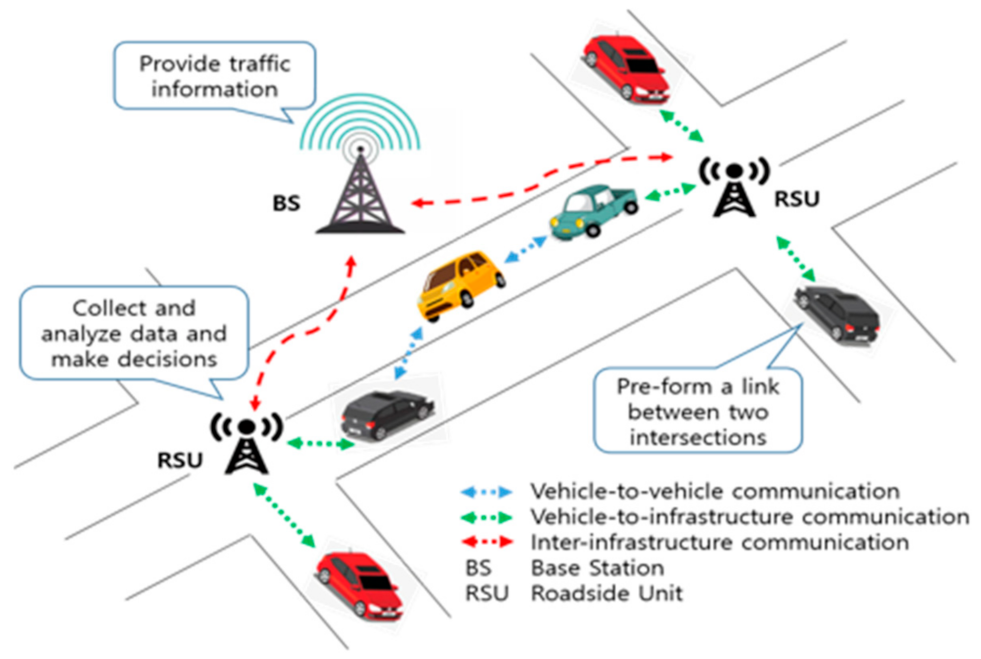
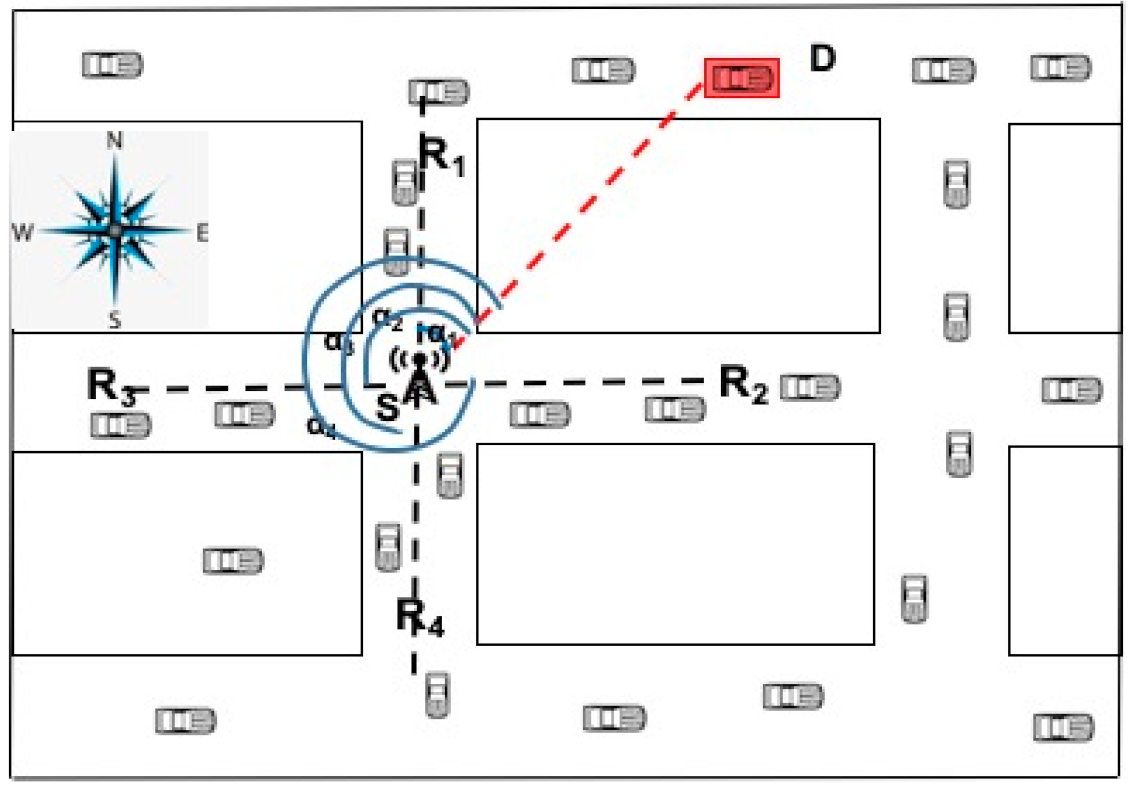
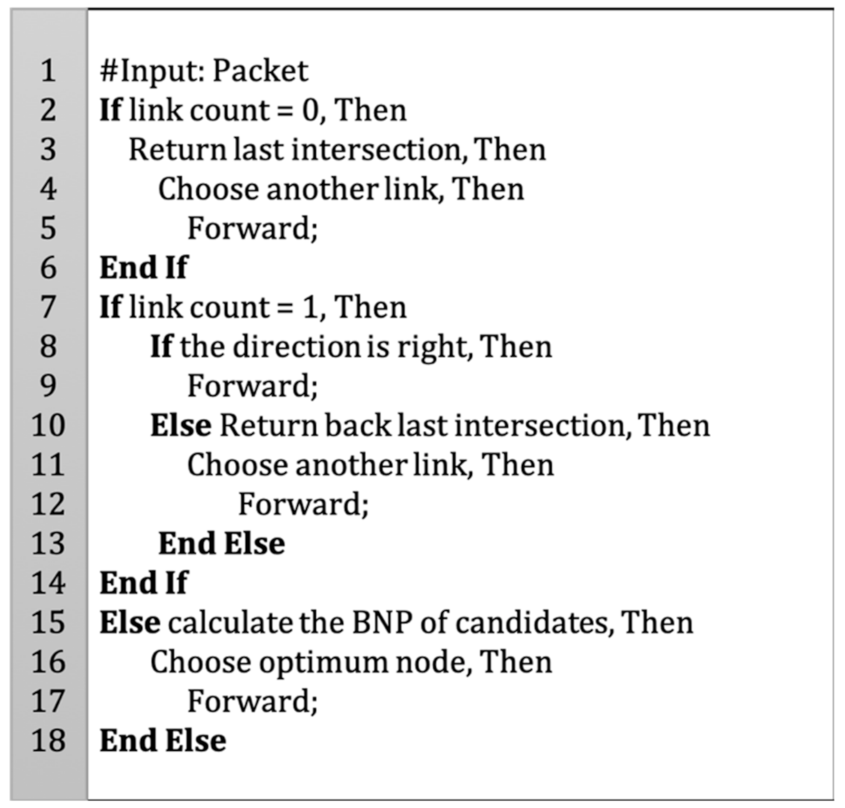
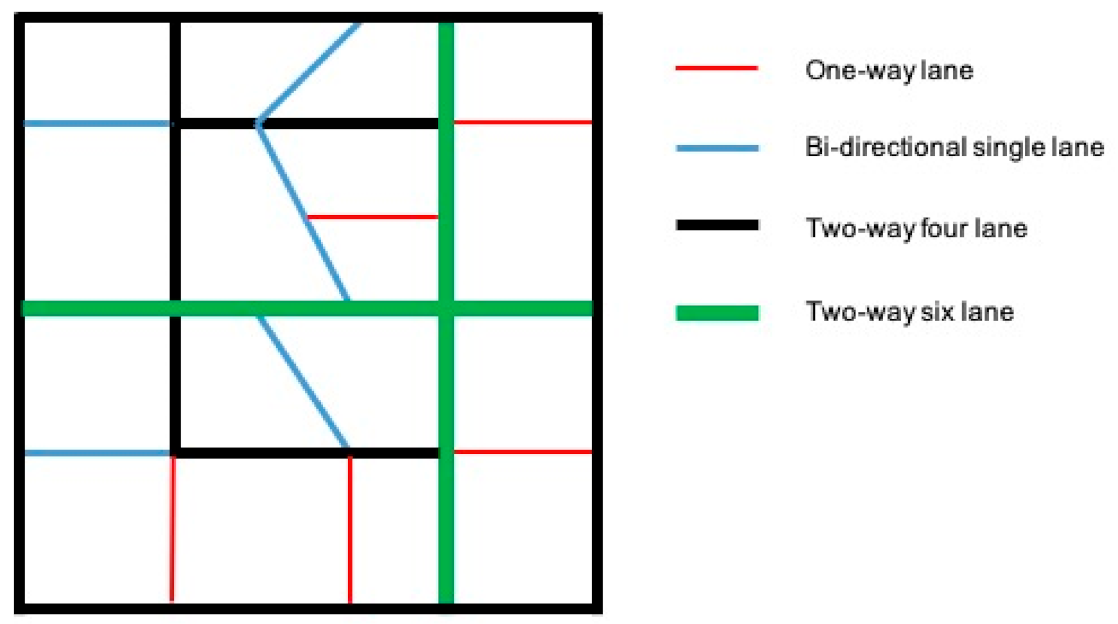
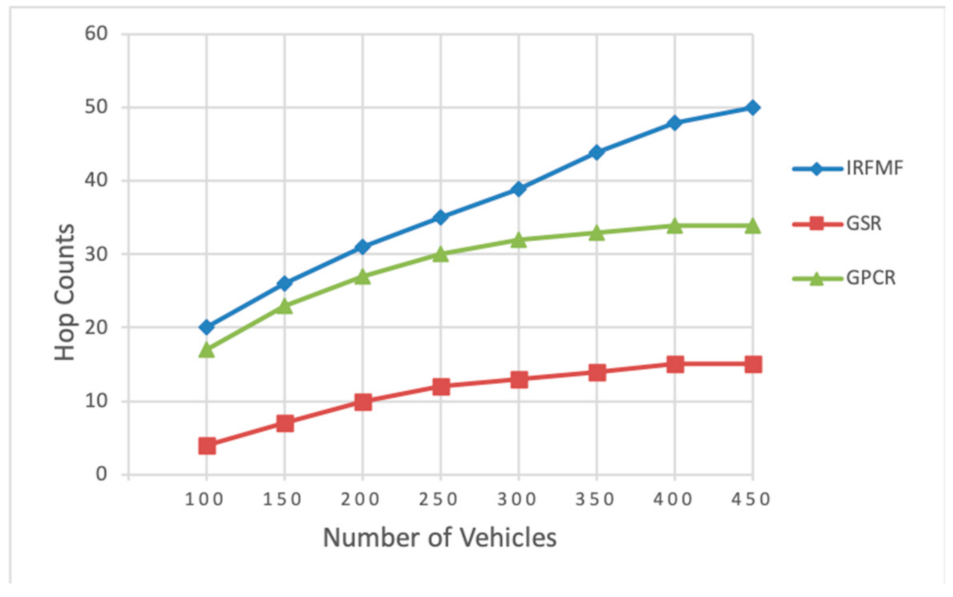


| Routing Protocol | Intersection Based | Multi-Factor Decision | Main Forwarding Strategy | Recovery Strategy | Advantage | Drawback |
|---|---|---|---|---|---|---|
| GPSR | No | No | Greedy | The right hand role | Easy and cost least | Can only be used in city scenarios |
| GPCR | Yes | No | Restricted Greedy | The right hand role | Easy and suitable for city scenarios | Anchor node redundancy at intersections |
| GSR | No | No | Greedy | Carry-and-forward | Sensitive to dynamic topology changes | High overhead and easy to lost packets |
| EGSR | No | No | Greedy | Carry-and-forward | No additional hardware required | High routing overhead |
| STAR | Yes | No | Traffic lights | Carry-and-forward | More applicable for city scenarios | High cost in calculation |
| GTLQR | Yes | Yes | Traffic lights and queue aware | Carry-and-forward | Suitable for urban high-density vehicle environment | High computing overhead |
| iCAR-II | Yes | Yes | Integrate VANET, cellular network, and location centers | Reschedules the transmission | Provide an efficient and dynamic data routing | Highly dependent on infrastructure |
| TAROC | Yes | Yes | Construct a data delivery path | Carry-and-forward | Safety and efficiency | Spend time on data collection |
| Vehicle ID | Road ID | Lane ID | Speed | Link Lifetime | Hop count | Link |
| Linguistic Variable | Triangular Fuzzy Number |
|---|---|
| Lower | |
| Low | |
| High | |
| Higher |
| Parameter | Value |
|---|---|
| Simulation area | 3000 m × 4000 m |
| Number of vehicles | 100~400 |
| Vehicle speed | 5~20 m/s |
| Radio range | 250 m |
| Data packet size | 1k |
| Packet sending rate | 4 pkt/s |
| Traffic type | CBR (Constant Bit Rate) |
| Packet lifetime | 1000 ms |
| Simulation time | 1000 s |
Publisher’s Note: MDPI stays neutral with regard to jurisdictional claims in published maps and institutional affiliations. |
© 2021 by the authors. Licensee MDPI, Basel, Switzerland. This article is an open access article distributed under the terms and conditions of the Creative Commons Attribution (CC BY) license (https://creativecommons.org/licenses/by/4.0/).
Share and Cite
Cao, Z.; Fan, Z.; Kim, J. Intersection-Based Routing with Fuzzy Multi-Factor Decision for VANETs. Appl. Sci. 2021, 11, 7304. https://doi.org/10.3390/app11167304
Cao Z, Fan Z, Kim J. Intersection-Based Routing with Fuzzy Multi-Factor Decision for VANETs. Applied Sciences. 2021; 11(16):7304. https://doi.org/10.3390/app11167304
Chicago/Turabian StyleCao, Zhenbo, Zujie Fan, and Jaesool Kim. 2021. "Intersection-Based Routing with Fuzzy Multi-Factor Decision for VANETs" Applied Sciences 11, no. 16: 7304. https://doi.org/10.3390/app11167304
APA StyleCao, Z., Fan, Z., & Kim, J. (2021). Intersection-Based Routing with Fuzzy Multi-Factor Decision for VANETs. Applied Sciences, 11(16), 7304. https://doi.org/10.3390/app11167304





